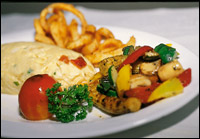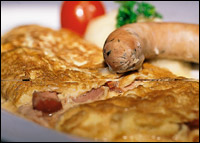


 The Perfect Omelette!
The Perfect Omelette!Know how to make the perfect omelette at home? No? Here's how you do it. And when you have mastered the art, venture out into the breakfast world of omelettes. Try out these ones UpperCrust recommends from France, Greece, Spanish, Thailand, Mexico, America, Germany and Norway. The procedure to make the omelette is the same. Only the stuffing differs. |
|
MAKING an omelette may seem like the simplest thing in the world, but how many of us can get it right? With that perfect shade of golden brown, and just fluffy enough so that it melts in the mouth? Here are a few pointers UpperCrust sourced from omelette experts that are guaranteed to help you make the perfect omelette at home. Start with selecting the eggs: The golden rule is to get the freshest and the best quality eggs. Egg shells are porous, so don't store them close to anything smelly, because the eggs will absorb the smell. If you are not sure about the freshness of the eggs, just try this little test. Put the egg in a bowl of water - if it sinks, it's fine, if it floats end up, it's turning but still just about okay; but if it bobs on its side, it's time to buy another egg. To make an omelette,
you will need:
Pick a pan: Beating the eggs: What next? Heat the butter and oil in your frying pan until it begins to foam. Now, swirl the fat around the pan so that it washes the sides, tip the egg mixture into it and turn up the heat. If the pan is already hot, the omelette seals and starts turning golden brown. Immediately, using a table knife in one hand and tipping the pan at different angles in the other, draw the setting egg towards the centre, so that more of the mixture hits the hot pan. This will produce a lovely light, ruckled effect in the setting egg. After 30 seconds, turn down the heat and leave the pan flat. There should still be plenty of runny egg on the top. What about salt and pepper? When is it ready to eat? Stuffing an omelette:
|

Home Page
 To make a thick omelette for one, use at least four eggs. If you use less eggs, you will end up with a very thin, measly omelette. A good thickness of egg will keep it melt-in-the-mouth light. Some people add a teaspoon of milk of cream in their egg mix. You may take it or leave it.
To make a thick omelette for one, use at least four eggs. If you use less eggs, you will end up with a very thin, measly omelette. A good thickness of egg will keep it melt-in-the-mouth light. Some people add a teaspoon of milk of cream in their egg mix. You may take it or leave it.